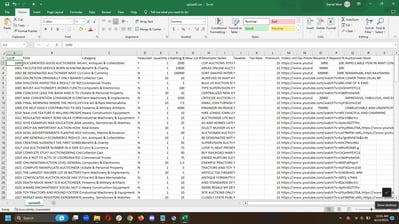2 min read
Taking Control of Your Auctions: The Whitelist Feature Explained
Auctions are a time-tested method for selling everything from fine art to real estate. They bring together buyers and sellers in an atmosphere of...

In the dynamic high-speed world of auctions, having efficient data-entry methods at your disposal is not just a convenience—it's a necessity. The process of cataloging lots can be a time-consuming and complex task, and any inefficiencies can lead to significant costs in terms of time, money, and peace of mind. Inefficient data-entry methods can result in errors, inconsistencies, and delays, all of which can impact the success of an auction and the satisfaction of both buyers and sellers. Moreover, these inefficiencies can lead to increased administrative workload and stress, detracting from the core focus of managing and promoting successful auctions. Therefore, the importance of having streamlined, user-friendly, and efficient data-entry methods, like those offered by AuctionMethod, cannot be overstated. These tools not only simplify the cataloging process but also contribute to a smoother, more successful auction experience for all involved.
AuctionMethod's software platform is designed to streamline the process of adding lots to an auction catalog. With three distinct data-entry methods and multiple editing options, the platform caters to a variety of use cases, making it a versatile tool for auction administrators. Let's dive into each of these methods and explore how they can be used to optimize the auction cataloging process.
 1. Auctioneer's Toolbox: Mobile App for On-the-Go Cataloging
1. Auctioneer's Toolbox: Mobile App for On-the-Go Cataloging
The Auctioneer's Toolbox is a mobile application available for both Android and Apple devices, designed to facilitate field data collection. This app is perfect for auction administrators who need to catalog items on-site, such as at an estate sale, a warehouse, or a client's home.
With a user-friendly interface, the app allows users to add a lot number, title, description, categorize it, and assign consignors. Users can then take pictures of the lot directly through the app or select previously-captured pictures from the device. The ability to create custom form-based templates ensures consistently accurate and complete item descriptions, which is particularly useful when cataloging similar types of items across multiple lots.
Multiple users can use the Auctioneer's Toolbox app simultaneously, meaning that your entire team can be used for cataloging at the same time. If they have internet connectivity in the field, then the data can be synced up with the website as they create the catalog, meaning that someone in the office can monitor, review, edit, and provide feedback on the cataloging process without having to be in the field. If the app users do not have internet access in the field, then the app will synchronize the data with the website when the device has internet access.
The Auctioneer's Toolbox also helps with the checkout process, but we'll cover that in a separate blog post.
%20(2).png?width=399&height=224&name=Copy%20of%20laptop%20px)%20(2).png) 2. Web-Based Data Entry: For Detailed Cataloging
2. Web-Based Data Entry: For Detailed CatalogingWeb-based data entry allows administrative users to add individual lots one-at-a-time or to catalog-by-picture, where they upload a bunch of pictures and then add additional information. This method is ideal for situations where detailed, in-depth descriptions are needed, or when high-quality images are available for upload.
The web-based data entry method offers the flexibility to work from any location with an internet connection, making it a great option for auction administrators working remotely or from an office setting. The intuitive interface is incredibly user-friendly, having been designed by and for auction administrators. There are options to make some data, such as the assigned consignor and item category, persist between auction lots so that it doesn't have to be entered each time. If you need to create a new category or add a consignor account, that can be done quickly without leaving the data-entry interface. A drag-and-drop tool makes it a cinch to rearrange photos and a built-in image editor editing tool makes it easy to crop, flip, rotate, flip, and add text to images on the fly.
 3. File-Upload Data Entry: For Bulk Cataloging
3. File-Upload Data Entry: For Bulk CatalogingFile-upload data entry allows administrative users to import auction lots by uploading a spreadsheet in CSV format. This method is particularly useful when dealing with large quantities of similar items, as it allows for bulk cataloging, saving significant time and effort.
With the file-upload data entry method, administrators can prepare their catalog offline at their own pace and then upload all the information at once. This method also reduces the risk of data entry errors, as information can be reviewed and corrected in the spreadsheet before upload.
When uploading a CSV file, the system will provide a file template and a sample file with sample data so that there is no guesswork involved in creating the file. Only two of the fields are required—lot numbers and titles. Other fields, such as quantity, starting bid, and whether the lots are taxable will be inherited from the auction settings or set to the site default if they are needed, or they are purely optional fields. If the file you are uploading contains categories that don't exist in the system, then there is a simple option to automatically create those categories when you upload the file.
With the option to overwrite existing data, the file-upload method is also a great tool to make wholesale changes to an auction catalog.
%20(3).png?width=399&height=224&name=Copy%20of%20Grey%20and%20White%20Minimal%20Women%20Fashion%20Products%20Catalogue%20Facebook%20Post%20(1920%20%C3%97%201076%20px)%20(3).png) EFFORTLESS editing: updating auction lots
EFFORTLESS editing: updating auction lotsOnce lots have been created using any of the data-entry methods, AuctionMethod's platform makes it easy for administrative users to edit lot information and pictures. The platform's batch update feature is a powerful tool that allows for mass modifications to selected lots or all lots in the auction. This includes the ability to append, prepend, and replace text in the titles and descriptions, ensuring that lot information is accurate and consistent across the board. If lot numbers need to be changed, a dedicated feature simplifies this process, making it quick and straightforward. Additionally, adding new pictures to lots or replacing existing ones is a breeze, allowing for continual improvement and optimization of the auction catalog. This flexibility in editing ensures that administrators can efficiently manage and update their auction catalogs as needed, enhancing the overall auction management process.
In conclusion, the efficiency and effectiveness of data-entry methods play a pivotal role in the success of an auction. AuctionMethod's software platform, with its versatile data-entry methods and robust editing features, provides a comprehensive solution that caters to a variety of cataloging needs. Whether you're an auction administrator working in the field, in an office, or handling large quantities of items, AuctionMethod equips you with the tools to streamline your cataloging process. By reducing the time and effort required for cataloging, you can focus more on what matters most - delivering a successful and satisfying auction experience for all participants. With AuctionMethod, you're not just managing an auction; you're crafting an experience that's efficient, engaging, and rewarding.
AuctionMethod Co-Founder Daniel West is a lifelong auction professional and visionary. When Daniel and his brothers needed integrated invoicing, communication, reporting, and payment tools to run their family auction business efficiently, they combined their knowledge of the auction world with their passion for technology and built them themselves. What began years ago as an internal fix has grown into a full-service solution trusted by auctioneers of all kinds. Today, Daniel helps auction companies optimize operations, grow their businesses, and keep more of every dollar they earn.
.png)
2 min read
Auctions are a time-tested method for selling everything from fine art to real estate. They bring together buyers and sellers in an atmosphere of...
.png)
2 min read
The Pickup Process Problem: A Free-for-All Approach Auction day is exciting, but pickup day? Not so much. Many auction companies simply set a...

5 min read
In the world of real estate, the auction method of marketing has proven to be a remarkably dynamic, efficient, and effective way of selling...